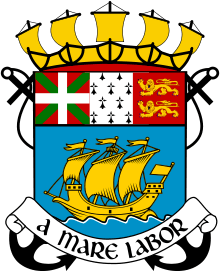Politics of Saint Pierre and Miquelon
 |
| This article is part of a series on the politics and government of Saint Pierre and Miquelon |
|
Politics of Saint Pierre and Miquelon takes place in a framework of a parliamentary representative democratic French overseas collectivity, whereby the President of the Territorial Council is the head of government, and of a multi-party system. Executive power is exercised by the government.
Executive branch
The head of state is President Francois Hollande of France as represented by Préfet (Prefect) Albert Dupuy (since 10 January 2005). The Prefect is essentially the Governor of the territory.
For more see Prefect of Saint-Pierre and Miquelon
Legislative branch
The Territorial Council of Saint-Pierre and Miquelon (French: Conseil territorial de Saint-Pierre-et-Miquelon), which was known until February 22, 2007 as the General Council (Conseil général), has 19 members, elected for a three-year term in single seat constituencies. The council sits at the Territorial Council Building, a two storey, two tone aqua colour building on St. Pierre.
Municipal Governments
There are two levels of local government, Miquelon-Langlade and Saint-Pierre.
For more see Municipal governments in St. Pierre and Miquelon
Judicial Branch
The judiciary of the territory consists of the Superior Tribunal of Appeals (Tribunal Superieur d'Appel).
The court resides at the Palais de Justice or Courthouse and are located at Church Square in St. Pierre.
Departments
A list of departments of St. Pierre and Miquelon (some local branch of national departments):
- La Direction de l'Agriculture et de la Foret - Department of Agriculture and Forests
- Le Service des Affaires Maritimes - Marine Department
- La Direction de l'Equipement - Infrastructure or Public Works
- Le Service du Travail, de l'Emploi et de la Formation Professionnelle - Labour and Employment Department
- La Direction Territoriale la Jeunesse et des Sports - Local Sports and Youth Department
- La Direction des Affaires Sanitaires et Sociales - Health and Social Affairs
- Le Service de l'Education Nationale - Education Department
- La Douane - Customs Department
- La Direction des Services Fiscaux - Finance Department
- La Gendarmerie Nationale - Local unit of the French Ministry of Defence
- La Gendarmerie Maritime : Le Fulmar - Marine Police (local branch of Maritime Gendarmerie)
- La Direction de la Concurrence, de la Consommation et de la Répression des Fraudes - Consumer Protection Department
- L'Aviation Civile - local branch of the Directorate General for Civil Aviation (France)
- La Police Nationale - local branch of the National Police (France)
Political parties and elections
| Votes | % 1st round | Seats | ||
|---|---|---|---|---|
| Archipelago Tomorrow (Archipel demain) | 2,045 | 66.22 | 16 | |
| Road to the Future (Cap sur l'avenir) | 939 | 30.41 | 2 | |
| Saint-Pierre and Miquelon Together (SPM ensemble) | 104 | 3.37 | 1 | |
| Total | 19 | |||
| Source: Wikipedia | ||||
Boundary dispute

See also: Canada–France Maritime Boundary Case
In 1992, a maritime boundary dispute with Canada over the delineation of the Exclusive Economic Zone belonging to France was settled by the International Court of Arbitration. In the decision, France kept the 12 nautical mile (NM) (22.2 km) territorial sea surrounding the islands and was given an additional 12 NM (22.2 km) contiguous zone as well as a 10.5 NM (19.4 km) wide corridor stretching 200 NM (370 km) south. The total area in the award was 18% of what France had requested.
The boundary dispute had been a flash point for Franco-Canadian relations. New claims made under UNCLOS by France over the continental shelf might cause new tensions between France and Canada.
International organization participation
Franc Zone, World Federation of Trade Unions
External links
- Saint-Pierre & Miquelon Information
- Saint-Pierre & Miquelon Community website, includes political discussions
- Saint-Pierre & Miquelon Continental Plate - "Defend Saint-Pierre & Miquelon"
- Le Conseil général de Saint-Pierre et Miquelon
.svg.png)